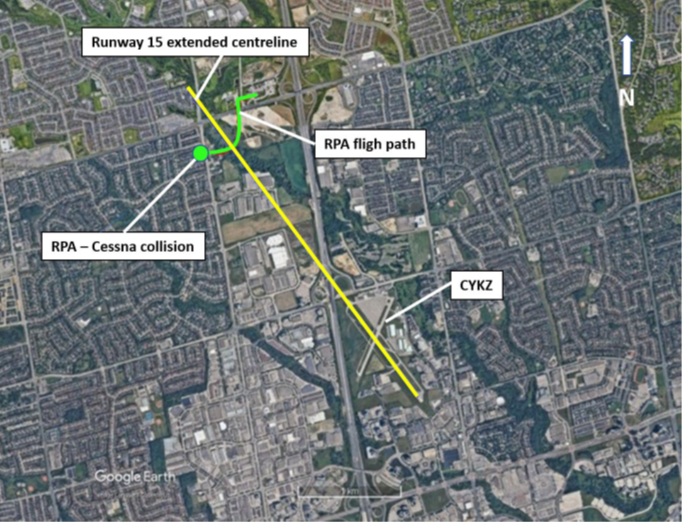The Charity
Aviation
Maritime
DUASxxx9
Initial Report
From Transportation Safety Board of Canada’s Air Transportation Safety Investigation Report A21O0069
On 10 August 2021, the Cessna 172N aircraft (registration C-GKWL, serial number 17268441) operated by Canadian Flyers International Inc. was on a day visual flight rules training flight, on final approach to Runway 15 at Toronto/Buttonville Municipal Airport, Ontario, with a student pilot and flight instructor on board.
At approximately 1301 Eastern Daylight Time, the student pilot and flight instructor heard and felt a solid impact at the front of the aircraft. Suspecting a bird strike, they continued the approach and made an uneventful landing, exiting the runway and proceeding to park on the ramp. After parking the aircraft, they observed damage on the front left cowl under the propeller; however, there were no signs that a bird had struck the aircraft.
Shortly afterward, a member of the York Regional Police reported to airport staff that he believed a collision had occurred between the remotely piloted aircraft he had been operating and another aircraft. The remotely piloted aircraft, a DJI Matrice M210 (registration C-2105569275), had been in a stationary hover at 400 feet above ground level when the 2 aircraft collided. The DJI Matrice M210 was destroyed. There were no injuries to either pilot on the Cessna 172N or to persons on the ground.
Findings as to causes and contributing factors (These are conditions, acts or safety deficiencies that were found to have caused or contributed to this occurrence):
- The flight crew of the Cessna 172N was unaware of the presence of airborne remotely piloted aircraft traffic in the vicinity and, due to several factors, the active scanning that is part of the see-and-avoid principle was unsuccessful in identifying the conflict.
- York Regional Police policy does not require that visual observers be trained crew members, and the remotely piloted aircraft pilot did not brief the visual observer on his role and responsibilities before the operation. As a result, the visual observer was not aware of the requirement to maintain visual line-of-sight with the remotely piloted aircraft, nor was he trained in visual scanning techniques or aircraft identification.
- The remotely piloted aircraft pilot was tasked with operating the camera system, monitoring the status of the remotely piloted aircraft, and communicating on multiple channels. As a result, he likely became task saturated, restricting his ability to visually monitor the remotely piloted aircraft and hear radio calls on the control zone’s mandatory frequency and the sound of incoming aircraft, both of which preceded the collision.
- In the moments leading up to the collision, the pilot of the remotely piloted aircraft likely was task saturated, the visual observer was unaware of the requirement to maintain visual line-of-sight, and the Cessna pilots’ active scan was unsuccessful; consequently, the conflict went unrecognized, and the 2 aircraft collided.
Findings as to risk (These are conditions, unsafe acts or safety deficiencies that were found not to be a factor in this occurrence but could have adverse consequences in future occurrences)
- If pilots do not consult established checklists before and during flight operations, there is a risk that checklist items deemed critical to the safety of the flight will be omitted.
- If remotely piloted aircraft operators who plan to operate in controlled airspace do not communicate their flight intentions with, and receive authorization from, the air traffic services provider, there is an increased risk of conflict or collision with another aircraft.

Damage to the Cessna 172 after collision with the DJI M210
Safety action taken:
The York Regional Police has amended its Command Directive LE-388 to include the addition of a pre-flight risk assessment tool and an updated Remotely Piloted Aircraft Pilot Checklist. There is also additional guidance for the role of visual observer, including a quick reference card outlining their roles and responsibilities, as well as a requirement to have a visual observer present for all operational remotely piloted aircraft flights.

Overview of Toronto/Buttonville Municipal Airport and surrounding area showing the collision location, the Runway 15 centreline, and the RPA’s flight path (Source: Google Earth, with TSB annotations)
CHIRP Comment
We think there are some good Human Factors lessons to take away from this report and are relieved that a more serious outcome did not result. This report shows how important it is to contact Air Traffic Control when you are flying in their FRZ, with precise details of where you will be flying. This applies even if there are operational reasons why time may be constrained. Although Emergency Services clearly have other considerations to consider as well, the safety of flight should not be made a secondary consideration to something they are doing even when the safety of life is just as much at stake. If the impact of the Drone had been a couple of inches higher it would have had an altogether different outcome we suspect.
An observer that is properly briefed can provide a significant amount of value to any RPAS flight, particularly if there is an element of urgency associated with the deployment. An observer that is not properly briefed may be distracted by the controller screen and not be looking at the Drone and its surroundings. Task saturation is never that far away when you are involved in an unpredictable situation and increases the chance that the holes in the Swiss cheese can align very quickly. In addition, Final approach can be a busy time for the crew of a light-aircraft, and it is not necessarily a moment when they would expect unannounced airborne conflicts. Better to be safe than sorry and get in touch with ATC when you are flying in an FRZ.